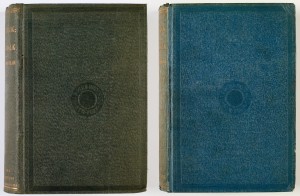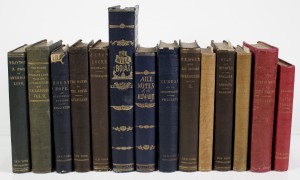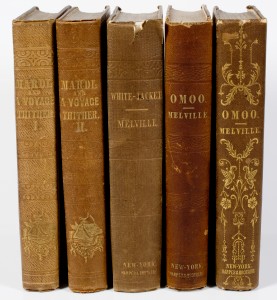Whenever it’s a damp, drizzly November (or January) in your soul, where do you go to keep from knocking people’s hats off? In Melville’s Moby-Dick Ishmael goes to sea, while the novel’s sub-sub librarian (Melville’s fictional assistant, assistant librarian who scours the earth for the “Extracts”) apparently retreats to literary references to the Leviathan. The sub-sub librarian in Ishmael reaches out to a fantastical cetology based on book format, Beale’s Natural History, and an only known copy of a book about the north wind. Some of us, who are less inclined to travel the world hunting either for whales or extracts about them, go to first editions of books like Moby-Dick—preferably if these first editions are owned by our own libraries.

The American Antiquarian Society has two copies of the first American edition of Moby-Dick. As is well-known by now, the American edition was published by Harper’s shortly after Richard Bentley released the London edition with a mutilated version of Melville’s novel in 1851. Both of AAS’s copies have the first edition binding stamped with the Harper’s device at center, one in blue cloth with bright orange endpapers and the other in green cloth with brown-orange endpapers.

Neither copy physically stands out from Harper’s many other publications of that year. Titles published in 1851 and owned by AAS include: Henry Cheever’s The Island World of the Pacific and Autobiography and Memorials of Captain Obadiah Congar; Thomas Haliburton’s Rule and Misrule of the English in America; Gideon Hollister’s Mount Hope; Charles Kingsley’s Alton Locke; Henry Mayhew’s London Labour and the London Poor; Emmeline Stuart-Wortley’s Travels in the United States; and William Henry Bartlett’s Nile Boat. The design of Harper’s books is homogeneous, and Harper’s desire to push out books with little embellishment for maximum gain is noticeable. Not only does Moby-Dick not stand out from the others, but its design can’t even compare to Nile Boat‘s. And Melville’s other works published by Harper’s around that time—Omoo (1847), Mardi (1849), Redburn (1849), White-Jacket (1850), Pierre (1852)—show almost nothing distinctive in individualized book design. Perhaps the lack of focus on design, as Jeffrey Groves has suggested about house styles, promoted uniformity for Harper publications, self-servingly making all publications appear the same as successful ones. Perhaps the neglect of fancy design elements simply allowed Harper’s to devote themselves to other aspects of book production, like making good books available for all.

So what do we wish to do with extracts, folio whales, and first editions except hope to discover some truth that brought us to these things in the first place? A.S.W. Rosenbach said in his preface to an edition of Moby-Dick published 90 years ago: “Melville has made the deep give up its dead; he has disclosed to us its long-hidden mysteries. But he has done more. He has revealed…the secrets of the soul.” It must be these secrets that keep us coming back to Moby-Dick in the sea of nineteenth-century mass-produced books.

Does the AAS have a copy of Beale’s 1835 monograph, A Few Observations on the Natural History of the Sperm Whale and his 1839 book, The Natural History of the Sperm Whale? You probable do but I have a facsimile of the former and a first edition of the latter which I can donate to the AAS once my research is completed.
Jack HT Chang, MD
AAS has neither book, and I would be extremely excited if you decided to donate them to us when your research is complete! Our curator of books will probably contact you via email soon.